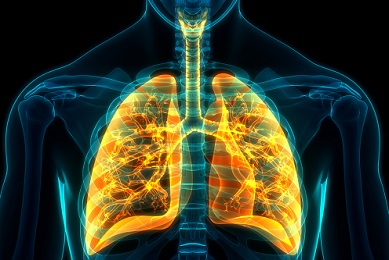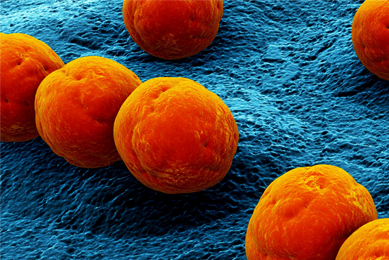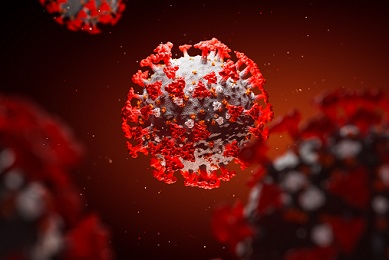Why it’s important
Lower respiratory infections are a leading cause of morbidity and mortality worldwide.1 The World Health Organization (WHO) reported that these infections globally accounted for the highest number of deaths due to communicable disease and were the fourth leading cause of death overall between 2000-2019.2,3 While the burden of lower respiratory infections had begun to decrease between 1990-2019 due to prevention programs,1 the emergence of SARS-CoV-2 in December 2019 precipitated a worldwide pandemic with a high mortality rate that has resulted in millions of deaths.4
The etiology of lower respiratory infections can be viral, bacterial, or fungal in nature; common respiratory pathogens include coronavirus, respiratory syncytial virus, influenza virus, parainfluenza virus, Streptococcus pneumoniae, and Haemophilus influenzae type b.1,5,6 These pathogens can cause a variety of symptoms such as chest pain, fever, dyspnea, and cough.7 Severe infections can lead to death, particularly in high-risk groups such as children under 2 years old, adults over 65 years old, or individuals with compromised immune systems or preexisting medical conditions.
Early and accurate diagnosis of the causative agent is essential for delivering appropriate therapies and initiating effective control measures to prevent further spread of disease. This is especially true regarding viral infections that lack specific therapeutic drugs. However, due to the nonspecific clinical manifestations of respiratory infections, differential diagnosis can’t be made based on symptoms alone. Further, diagnosis can be complicated during instances of coinfection or secondary infection.8
With the cold weather months rapidly approaching in the Northern Hemisphere, we will soon see seasonal spikes in cases of respiratory infections such as influenza, RSV, COVID-19, and pneumococcal disease, among others.9 Rapid and accurate detection of the underlying respiratory pathogen will be essential for timely and effective treatment.
What’s the solution?
Molecular diagnostic assays provide a rapid, specific, and sensitive method for pathogen detection and quantification.10 These assays offer the benefit of scalability and the ability to detect low pathogen loads. Furthermore, molecular diagnostic assays can be built as single PCR assays for specific pathogens or as multiplex platforms for the simultaneous detection of two or more pathogens. The latter assay type has the advantage of detecting coinfections and the potential to save time and effort; however, optimization may be challenging.10,11
How we can help
When developing a molecular diagnostic assay, robust testing must be performed to ensure that it is sensitive and specific. ATCC supports these validation studies by providing a variety of authenticated and clinically relevant materials for evaluating limit of detection, inclusivity, and cross-reactivity. Our extensive collection contains a variety of viral, bacterial, and fungal species for respiratory molecular diagnostics development, including high-priority organisms that could be present in respiratory specimens. We provide these materials in a variety of formats, including heat-inactivated preparations, live strains, high-titer viruses, genomic and synthetic nucleic acids, and inclusivity and exclusivity panels. Many of these strains have also been whole-genome sequenced, and their reference-quality genome is available on the ATCC Genome Portal.
Did you know?
ATCC provides respiratory pathogen panels that support inclusivity and exclusivity testing for SARS-CoV-2 diagnostics development.
Meet the author
Cara Wilder, PhD, ELS
Senior Scientific Writer, ATCC
Dr. Wilder is a Senior Scientific Writer at ATCC. She has a PhD in Microbiology with background experience working with several pathogenic bacterial species in both in vitro and in vivo environments. Dr. Wilder is the author of numerous publications on varying topics of scientific relevance, including quality control, microbial contamination, assay development, proficiency testing, and multidrug resistance.
Explore our resources for respiratory diagnostics development

Respiratory Diagnostics
ATCC provides a variety of authenticated and clinically relevant materials for evaluating limit of detection, inclusivity, and cross-reactivity of novel respiratory molecular diagnostic assays.
More
Respiratory Diseases
At ATCC we offer the authenticated viruses, bacteria, fungi, and derivatives needed for the development and validation of novel preventative and therapeutic techniques for respiratory infectious diseases.
More
SARS-CoV-2 Molecular Diagnostics Development
ATCC provides a variety of authenticated and clinically relevant materials for evaluating limit of detection, inclusivity, and cross-reactivity of novel SARS-CoV-2 molecular diagnostic assays.
MoreReferences
- Safiri S, et al. Global burden of lower respiratory infections during the last three decades. Front Public Health 10: 1028525, 2022.
- World Health Organization. The top 10 causes of death. Accessed online July 2023 <https://www.who.int/news-room/fact-sheets/detail/the-top-10-causes-of-death>. Last updated December 2020.
- World Health Organization. Leading causes of death and disability: A visual summary of global and regional trends 2000-2019. Accessed online July 2023 <https://www.who.int/data/stories/leading-causes-of-death-and-disability-2000-2019-a-visual-summary>.
- World Health Organization. WHO Coronavirus (COVID-19) Dashboard. Accessed online July 2023 < https://covid19.who.int/>.
- Lukšić I, et al. Viral etiology of hospitalized acute lower respiratory infections in children under 5 years of age – a systematic review and meta-analysis. Croat Med J 54: 122-134, 2013.
- Troeger C, et al. Estimates of the global, regional, and national morbidity, mortality, and aetiologies of lower respiratory infections in 195 countries, 1990–2016: a systematic analysis for the Global Burden of Disease Study 2016. 18: 1191-1210, 2018.
- Centers for Disease Control and Prevention. Respiratory Infections: CDC Yellow Book 2024. Accessed online <https://wwwnc.cdc.gov/travel/yellowbook/2024/posttravel-evaluation/respiratory-infections#:~:text=Lower%20respiratory%20tract%20infections%2C%20particularly,or%20lower%20respiratory%20tract%20infections>. Last updated May 2023.
- Maltezou HC, et al. COVID-19 and Respiratory Virus Co-Infections: A Systematic Review of the Literature. Viruses 15(4): 865, 2023.
- Wiemken TL, et al. Seasonal trends in COVID-19 cases, hospitalizations, and mortality in the United States and Europe. Sci Rep 3(1): 3886, 2023.
- Zhang N, et al. Recent advances in the detection of respiratory virus infection in humans. J Med Virol 92(4): 408-417, 2020.
- Mancini F, et al. Multiplex Real-Time Reverse-Transcription Polymerase Chain Reaction Assays for Diagnostic Testing of Severe Acute Respiratory Syndrome Coronavirus 2 and Seasonal Influenza Viruses: A Challenge of the Phase 3 Pandemic Setting. Journal of Infectious Diseases 223(5): 765-774, 2021.